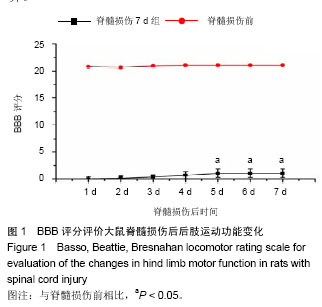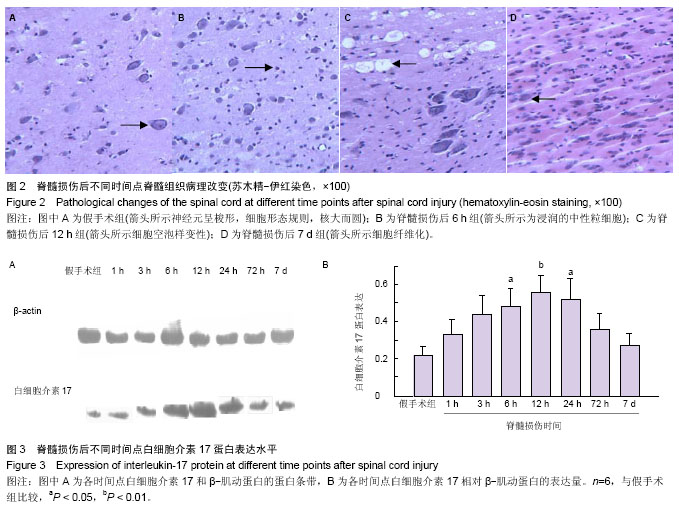设计:随机对照动物实验。
时间及地点:实验于2012年6月至2013年6月在军事医学科学院毒物药物研究所完成。
材料:
|
白细胞介素17与脊髓损伤相关性实验所用主要试剂及仪器:
|
|
试剂及仪器
|
来源
|
|
兔抗白细胞介素17单克隆抗体
|
R&D公司
|
|
反转录试剂及SYBR Premix Ex Taq II
|
TAKARA公司
|
|
实时荧光定量PCR仪、电泳仪、半干电转膜仪和凝胶成像仪
|
美国Bio-Rad公司
|
|
实验动物:健康雄性Sprague-Dawley大鼠112只,体质量220-240 g,SPF级,由北京维通利华实验动物技术有限公司提供。随机分为假手术组14只和模型组98只,其中模型组按脊髓横断后不同时间点(1,3,6,12,24,72 h,7 d)分为7组,每组14只。
实验方法:
脊髓完全横断模型的制备:2%戊巴比妥钠(40 mg/kg)腹腔注射麻醉大鼠,俯卧位固定。以T10椎体为中心剪毛、消毒,纵行切开背部皮肤,钝性分离皮下组织和肌肉,暴露T8-9棘突,去除棘突及椎板至横突根部,暴露T9-10节段脊髓,纵行剪开硬脊膜后,模型组以显微剪一次性完全横行剪断脊髓。假手术组仅剪开硬脊膜而不伤及脊髓实质。术毕逐层缝合肌肉、皮下组织和皮肤。术后大鼠正常饮食,模型组每日早晚2次按摩膀胱以助排尿。
动物模型成功的判定标准:横断后抬起脊髓两断端,确认脊髓完全横断,横断时大鼠出现摆尾反射,双后肢及躯体回缩样扑动,清醒后双后肢瘫痪,双前肢运动功能正常。
开放后肢运动功能评分(BBB评分)评价行为学改变:术前评估各组大鼠后肢运动情况,术后对假手术组和脊髓损伤7 d组大鼠进行BBB评分,由2名熟悉BBB评分的非实验人员独立观察并记录所有大鼠后肢关节活动的数目和范围,负重程度及前后肢协调性,前后爪和尾部的活动情况。评分过程选择在晚上20:00进行,时间为4 min,最后取均值。评分前检查大鼠有无膀胱充盈、会阴炎症、后肢外伤等,避免因上述情况而影响评分。
苏木精-伊红染色观察组织病理学改变:各组大鼠经2%戊巴比妥钠腹腔注射麻醉,仰卧位固定于操作台上,提起剑突下缘上腹部皮肤,纵行切开胸前部皮肤直至锁骨上,提起剑突一周沿胸骨前壁剪开膈肌,沿胸骨旁线剪开胸壁固定,剪开心包暴露心脏。从心尖部沿左心室插入灌注针至升主动脉入口,剪开右心耳,先用4 ℃生理盐水200 mL快速冲洗组织内血液,然后用4 ℃ 40 g/L多聚甲醛磷酸缓冲液(pH 7.4) 300 mL冲洗灌注(先100 mL快速灌注,然后200 mL缓慢灌注,共约1 h),直至肝脏褪色变硬,四肢、颈、尾僵硬。充分固定后,取以损伤区为中心的1 cm脊髓,40 g/L多聚甲醛固定液后固定2 h,20%蔗糖4 ℃过夜。组织沉底后用冰冻切片机作连续矢状面切片,片厚15 μm,隔五取一,贴于明胶预处理的载玻片上。苏木精-伊红染色:将预存的切片从-20 ℃冰箱取出,具体染色步骤如下:①二甲苯透明2次各10 min。②无水乙醇2次各5 min。③梯度乙醇使切片至水:体积分数为95%乙醇3 min×2次,体积分数为80%乙醇3 min×2次,蒸馏水3 min。④苏木精染色 15 min,清水冲洗5 min。⑤1%盐酸乙醇分化数秒,清水冲洗3 min。⑥体积分数为70%乙醇2 min,体积分数为80%乙醇2 min。⑦伊红复染15 s,自来水冲洗2 min。⑧体积分数为95%乙醇2 min×2次,体积分数为100%乙醇 2 min×2次。⑨二甲苯2 min×2次。⑩中性树胶封固,通风处晾干。光学显微镜下观察脊髓损伤后局部组织病理变化。染色结果判定:细胞核被苏木精染成蓝色,胞质被伊红染成粉红色,与蓝色的细胞核形成鲜明对比。
|
BBB评分具体评分标准如下:
|
|
后肢运动情况
|
得分
|
|
无可见后肢运动
|
0分
|
|
1或2个关节轻微运动,通常为髋和/或膝关节
|
1分
|
|
1个关节广泛活动或1个关节广泛活动且有另1个关节轻微活动
|
2分
|
|
2个关节广泛活动
|
3分
|
|
后肢全部3个关节可轻微活动
|
4分
|
|
2个关节轻微活动,第3个关节可广泛活动
|
5分
|
|
2个关节广泛活动,第3个关节可轻微活动
|
6分
|
|
后肢全部3个关节可广泛活动
|
7分
|
|
非承重情况下可以爪掌面着地
|
8分
|
|
间或爪掌面承重支撑或爪背面承重移动,无爪掌面支撑移动
|
9分
|
|
偶见爪掌面承重移动;无前后肢协调动作
|
10分
|
|
可较多的见到掌面承重移动,但无前后肢协调动作
|
11分
|
|
可较多的见到掌面承重移动,偶见前后肢协调动作
|
12分
|
|
常见掌面承重移动,可常见前后肢协调动作
|
13分
|
|
有持续性掌面承重移动和前后肢协调动作;或出现常见的掌面移动,持续型前后肢协调动作,偶有爪背侧移动
|
14分
|
|
持续性掌面移动和持续性前后肢协调动作,前肢前进过程中无或欧有抓地;初接触时主动爪位置与身体平行
|
15分
|
|
步态中可见持续性掌面移动和持续性前后肢协调动作,前肢前进过程中常见爪抓地;初接触时主动爪位置与身体平行,负重转移后旋转
|
16分
|
|
步态中可见持续性掌面移动和持续性前后肢协调动作,前肢前进过程中常见爪抓地;初接触时和负重转移后主动爪位置均与身体平行
|
17分
|
|
步态中可见持续性掌面移动和持续性前后肢协调动作,前肢前进过程中可持续性爪抓地;初接触时主动爪位置均与身体平行,负重转移后旋转
|
18分
|
|
步态中可见持续性掌面移动和持续性前后肢协调动作,前肢前进过程中可持续性爪抓地;初接触时和负重转移后主动爪位置均与身体平行。尾巴有时或总是下垂
|
19分
|
|
持续性掌面移动,持续性协调步态,足趾持续抓地,初接触时和负重转移后主动爪位置均与身体平行,躯干不稳定,尾巴持续翘起
|
20分
|
|
持续性掌面移动,持续性协调步态,足趾持续抓地,活动过程中主动爪位置始终与身体平行,躯干持续稳定,尾巴持续翘起
|
21分
|
|
RT-qPCR检测急性脊髓损伤大鼠局部组织白细胞介素17 mRNA表达水平:
RNA抽提和反转录cDNA:取以损伤区为中心1 cm的脊髓组织,Trizol法抽提总RNA,紫外分光光度计检测吸光度A260/A280,并计算其纯度和浓度。
在1 μg总RNA样本中加入gDNA Eraser 0.5 μL,5×缓冲液2 μL,无RNase水至10 μL。反应条件:42 ℃变性2 min,以消除可能存在的gDNA。PrimeScript RT Enzyme 0.5 μL,Oligo dT 引物(50 μmol/L)0.5 μL,随机引物(100 μmol/L) 0.5 μL,5×缓冲液2 μL,已去除gDNA的RNA10 μL,无RNase水至20 μL。反应条件:37 ℃ 15 min,85 ℃ 5 s。反应产物置于-20 ℃冰箱长期保存。
实时荧光定量RT-PCR:根据白细胞介素17和β-actin基因在GenBank的序列,经Primer Express3.0软件设计引物(表1),并由Invitrogen公司合成。应用 SYBR Premix Ex Taq Ⅱ(TaKaRa)实时荧光定量PCR试剂盒,以5倍稀释5个浓度梯度的cDNA样本,分别建立白细胞介素17和β-actin基因扩增的标准曲线,确定它们的扩增效率。反应体系25 μL包括:SYBR Ex Taq 12.5 μL,上游引物(10 μmol/L) 0.5 μL,下游引物(10 μmol/L) 0.5 μL,cDNA (10 μmol/L) 0.5 μL,ddH2O 11 μL。扩增条件:95 ℃预变性3 min,95 ℃变性30 s,60 ℃退火30 s,72 ℃延伸30 s,40个循环,每次循环结束后采集荧光。为确定扩增反应的特异性,循环结束后进行熔解曲线的分析,条件如下:65-95 ℃,每5 s上升0.5 ℃。每组样品设定无cDNA模板反应孔为阴性对照,每个样本进行3次重复,重复间允许差异小于0.5 Ct。用BioRad ManagerTM软件测定每个样本的相对拷贝数。
表1 实时荧光定量PCR引物序列
Table 1 Primer sequences of real-time fluorescence quantitative PCR
|
|
基因
|
引物序列
|
引物长度
|
|
白细胞介素17
|
F:5’-GGA GGA TAA CAG TGT AGA GAG-3’
R:5’-ATT TCT TGC TGG ATG GGA C-3’
|
126 bp
|
|
β-actin
|
F:5’-GGG AAA TCG TGC GTG ACA TT- 3’
R:5’- GCG GCA GTG GCC ATC TC- 3’
|
76 bp
|
|
Western blot法检测急性脊髓损伤大鼠局部组织白细胞介素17蛋白表达水平:取各时间点以损伤区为中心1 cm的脊髓组织,加入蛋白裂解液1 mL,制备组织蛋白匀浆液,BCA法蛋白定量后按每孔40 μg蛋白加样,SDS-PAGE(分离胶15%,浓缩胶5%)电泳分离后,利用半干法将蛋白转移至PVDF膜上。5%脱脂奶粉室温封闭3 h。
加入5%脱脂奶粉稀释的一抗,分别为兔抗白细胞介素17单克隆抗体(1∶250),内参小鼠抗β-肌动蛋白抗体(1∶1 000),4 ℃孵育过夜。次日用Tris缓冲液-吐温-20溶液(TBST)洗去多余的
一抗。加入TBST稀释的HRP标记的山羊抗兔/小鼠二抗(1∶2 000),室温振摇孵育1 h。用TBST洗去多余的二抗,加入ECL发光液,暗室中曝光。凝胶图像分析其积分吸光度值,白细胞介素17的相对表达量用β-肌动蛋白的表达量校正,即目的蛋白相对表达量=
IA白细胞介素17/
IAβ-肌动蛋白。
主要观察指标:①脊髓损伤大鼠后肢运动功能恢复情况。②脊髓损伤大鼠局部组织病理改变。③脊髓损伤大鼠局部组织白细胞介素17 mRNA表达水平。④脊髓损伤大鼠局部组织白细胞介素17蛋白表达水平。
统计学分析:实验结果数据用x±s表示,采用SPSS 16.0统计学软件进行处理。组间比较采用单因素方差分析。

